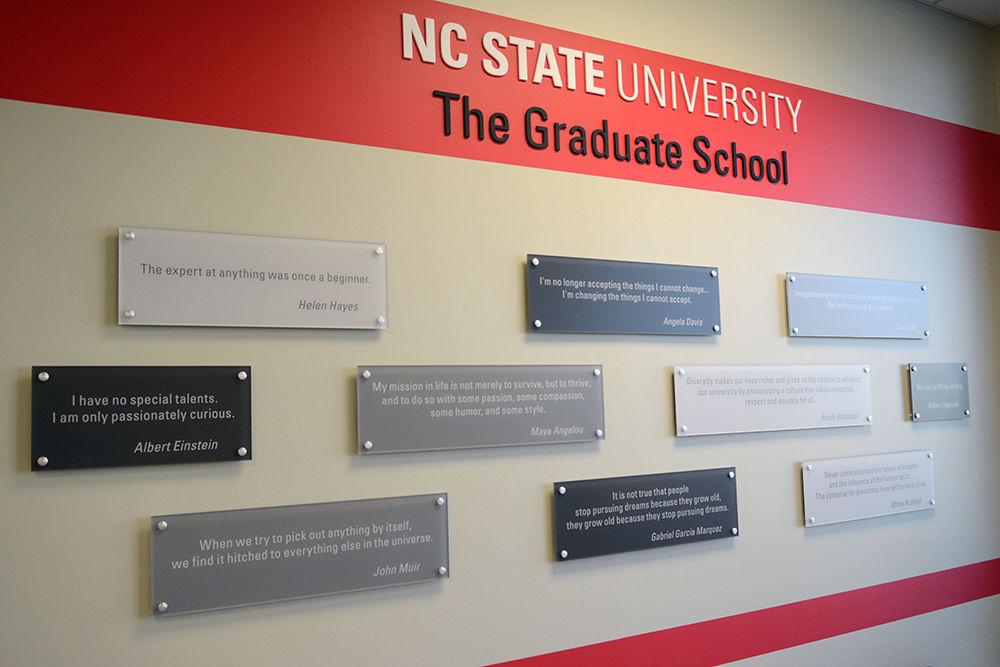
Adarsh Puvvadi Ramamohan Kumar
Walls plaques display famous quotes in the Graduate School Office. The Graduate School Building is located to the right of Wilson College of Textiles in the Centennial Campus. The Graduate School caters to the masters and doctoral students at NC State.
Did you know assistantships make up a significant portion of student jobs offered by the University? These jobs play a crucial role in ensuring a university’s success, but what exactly is an assistantship?
Assistantships are employment opportunities for graduate students which allow them to work on a part-time or full-time-equivalent basis for the University for a set, generally hourly, rate. According to the Graduate School, NC State offers four general types of assistantships — teaching, research, extension and services.
Graduate teaching assistants are most commonly known by the student population. They teach classes within a specific academic department or program, and generally work directly with students and professors. Graduate research assistants are also appointed within a specific department, but work with the research department to further experiments, studies and/or data collection being performed by the University.
Graduate extension assistants work in outreach and engagement to further a specific program or department, and generally work with individuals or groups beyond the University. Graduate services assistants work outside of specific departments or programs, serving the University in other ways, such as in administrative or bureaucratic positions.
Though all assistantships have a significant amount of work, the specific requirements for each type of assistantship can vary and can be found in the University Catalog. Peter Harries, dean of the Graduate School, explained the basic requirements for staying in an assistantship program.
“A student must be in graduate standing, enrolled full-time in fall/spring semesters and must be in good academic standing (GPA of at least 3.0), and making satisfactory degree progress,” Harries said.
According to the Graduate School, once through the application process, assistants can be employed on a quarter-, half-, three-quarter- or full-time appointment. These come with hourly requirements in proportion to a 40-hour work week, meaning a half-time employee is expected to fulfill 20 hours per week on their assistantship duties, and a quarter-time employee is expected to fulfill 10 hours.
These hours can look very different depending on the college a student is employed in. Genevieve Gauthier, a teaching assistant in the College of Engineering, said most of her hours with large E101 and E102 freshman classes consist of answering emails, grading assignments and other routine work.
While workloads can look similar for those in humanities or foreign language assistantships, more subjectively-graded assignments such as essays and projects can mean more time grading, and more room for an assistant’s personal style and preferences to show through their grading and advice given to students.
According to Gauthier, smaller class sizes allow her to form a deeper connection with students and understand them better. Larger classes require her to save more time for grading, leaving less room to connect with students.
Assistantships are paid positions, and while all assistants are paid bi-weekly, the pay itself varies as students are employed by individual colleges and programs, not by the Graduate School as a whole. According to Harries, payment levels are determined by the individual programs or the stipend allowed for students funded by grants. This means programs can set their hourly rates, determine hours required for assistants and decide whether assistants receive incremental pay increases as their time in the assistantship program increases.
According to Gauthier, sometimes the amount students get paid doesn’t seem fair.
“The pay for E101 and E102 is a fixed rate regardless of how much experience you have as a TA,” Gauthier said.
While statutes like those described by Gauthier leave room for criticism, the pay is not a large reason students choose to become assistants, but rather to make connections or pass along knowledge.
“I really enjoy passing along specific engineering opportunities to students knowing that something may spark their interest or sway them towards an engineering major before having to CODA,” Gauthier said.
When considering an assistantship, advantages and disadvantages should be weighed, and these can vary depending on the program and a prospective assistant’s priorities. According to Gauthier, advantages to becoming an assistant can include flexible hours, connection with professors, networking opportunities in your program and experience in communication and teaching.
“The professors I have TA’ed for have always been supportive and ensure I am able to handle the workload,” Gauthier said.
Gauthier said disadvantages of assistantships include time-intensive grading, difficulty working with students in an online format, payment gripes and feeling unfulfilled when the work was more grading than student-based discussions. But overall assistantships are an appealing and competitive form of employment for those pursuing master’s degrees, and most graduate students don’t get assistantships.
“The number of master’s students supported is a much smaller proportion of that population and generally focused on those pursuing master’s that require a thesis,” Harries said.
To learn more about assistantships, visit the University Catalog.